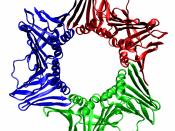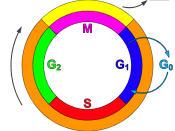Mitosis in cancerous cells Mitosis, the process in which a cell undergoes nuclear division, is one of the four subdivisions of the cell cycle responsible for cell growth and reproduction. The first step in mitosis is prophase. In prophase the chromatin, diffuse in interphase, condenses into chromosomes. Each chromosome duplicates and has become two sister chromatids. At the end of prophase, the nuclear envelope breaks down into vesicles. The following step in mitosis is metaphase. During metaphase the chromosomes align at the equator of the cell and are held in place by microtubules attached to the spindle and part of the centromere. Next is anaphase, in which the centromeres divide. The sister chromatids separate and move toward opposite poles. The last phase of mitosis is telophase. Here the daughter chromosomes arrive at the poles and the microtubules disappear. The cytoplasm divides, cell membrane closes inward making two daughter cells.
This is a very complex process which needs to be completed perfectly, in order for the cell to divide and replicate normally.
Very often a cell loses its regulation, and begins replicating out of control, that is it becomes cancerous.
Abnormal cell growth is often known as cancer. During which, cancer cells do not respond normally to the body's control mechanisms. They often divide excessively, invade other tissues and, if unchecked, can kill the whole organism. Researchers studying cancer cells in culture have found that they do not respond to the normal signals that stop growth such as contact inhibition. They continue to grow until nutrients in the growth medium are exhausted. Other differences exist between normal and cancer cells. These indicate abnormalities in the cell cycle of cancer cells. Cancer cells that stop dividing do so at random points in the cycle, instead of the restriction point in G1 also...


